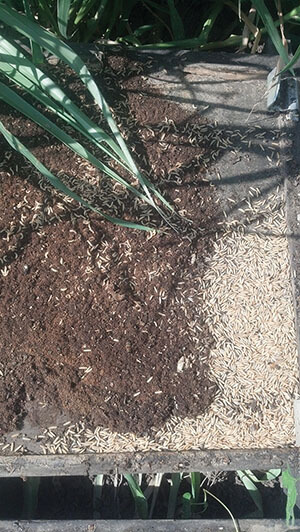
Alfred Hitchcock would have loved the small hive beetle, Aethina tumida. If he had only known, he might have scrapped his movie The Birds in favor of The Beetles. Small hive beetles lead a horror story life, fraught with mystery, intrigue, and destruction. The beetles, aided by their partner in crime—a symbiotic yeast—produce slime, mimic pheromones, and ferment honey. And if that’s not odd enough, an adult hive beetle can coax a honey bee worker into feeding it. Even the larvae are creepy. Reminiscent of fictional lemmings that leap from cliffs, beetle larvae of a certain age travel in packs and dive from the hive entrance to the ground below. Weirdness knows no bounds.
In its homeland of sub-Saharan Africa, the small hive beetle is only a minor pest. Having evolved together with the local honey bees, Apis mellifera scutellata and A. m. capensis,1 the small hive beetles are kept in check and do not normally destroy colonies of honey bees.2 However, once it crossed oceans, the small hive beetle found a vulnerable host without a ready defense. The European sub-species of honey bees are easy prey, partly because they abscond less frequently than the African bees. In addition, they leave more resources behind for the beetles to consume when they do abscond.3
Widespread Damage
Since the small hive beetle was first spotted in North America in 1996, it has spread rapidly, defying predictions about its inability to survive in colder climates. It was first reported in both Canada and Australia in 2002 and has since scattered throughout other regions as well.
Damage to colonies infected by small hive beetles can be severe, potentially causing colony demise. In the early years after its introduction, the small hive beetle seemed to be a problem limited to weak or small colonies, or to unguarded honey houses and stored equipment. But more recently, beekeepers have reported that even large and robust colonies can be destroyed by the beetles. Elevated beetle populations, especially those that approach 1,000 adults per hive,4 are especially problematic.
An adult small hive beetle may enter a hive along with a nucleus colony, a package, or a split. Or, left to its own devices, a beetle may discover a colony by detecting honey bee pheromones or other attractive hive odors.5
Imagine Life in their Shoes
To better understand the life cycle of these creatures, suppose for a moment you are one. Let’s say you, Bonnie the Beetle, emerged from the soil a week ago. Before doing anything else, you mate with the handsome dudes in your area. After a week or so,6 you go for a nice long flight to look for a place to live and raise your young. There’s no point in staying too close to home because lovely, habitable hives are everywhere.
You find a suitable domicile by sniffing the air. Honey bee alarm pheromone smells inviting, as do the odors of pollen, ripening honey, and bee brood. Your ability to fly about six miles (10 km) makes this an easy task.1 Once you find a hive you like, you simply fly in. What a relief to be out of the light!
Laying your Eggs
Where you lay your eggs depends on how welcoming your hosts decide to be. If the host bees are friendly, you may lay your eggs atop stored pollen or directly on bee brood. To reach the brood, you chew a tiny hole through the wax cappings or make a small slit in the side of a brood cell. With your long and flexible ovipositor, you can reach deep into protected places. You drop your clutch of eggs—a dozen or two—in the tight space and then move on to another. With a little luck, you may lay 1000 eggs, or maybe double that, in your lifetime.4
If the host bees are not so benevolent, you may decide to leave your eggs in cracks and slits along the edge of the brood nest. Unprotected eggs may be eaten by worker bees, so site selection is important. You want to avoid ornery bees, so you seek tiny out-of-the way crevices where they can’t quite reach you. If in doubt, you try the secluded spaces between the top bars, in feeders, in the corners of the bottom board, or up on top of the inner cover. It’s a world of choices.
Avoiding the Jailers
Still, caution is necessary. Sometimes an army of cranky nurse bees will corral you and your friends into a corner, denying you food and preventing access to the brood nest. With no get-out-of-jail-free cards, you are incarcerated behind a line of guards that watches you 24/7.
At such times, you must be devious. Play nice. If you stroke the bees’ mandibles with your antennae, they will eventually feed you. When she receives just the right touch, a nurse bee will extend her proboscis into your waiting mouth and, in a process called trophallaxis, share regurgitated nectar from her honey stomach.4 How sweet it is. And remember, patience pays. You can play this waiting game for 180 days or more.2
Meanwhile, while you’re marking time behind bars, your eggs begin to hatch. Within 2-4 days, hungry larvae emerge and ….


